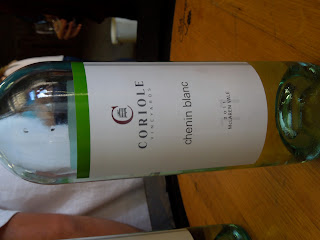Here's a little background info on Coriole (we visited this winery on our field trip to McLaren Vale):
Established by the Lloyd family in 1967, Coriole has become known for their Shiraz (accounting for 65% of their vineyard space), Sangiovese, and Chenin Blanc. In total, there are 25 various vineyards--some new (3 years), some old (90 years). Just this year, they began the shift to organic viticulture. According to the website, "Coriole owns or manages most of the vineyards where our grapes are sourced. One of the features of the winemaking is that each block or part of a block are processed separatly to maximise the potential of the fruit. This also allows the wine quality to be linked to the vineyard management of each block. Winemaking at Coriole is a very traditional process. Red wines are mainly open fermented in stainless steel or old wax lined concrete tanks. Ferments are hand plunged. New oak is used but many wines such as Sangiovese and Redstone Shiraz are specifically matured in older oak to gain maturity but with minimum contribution of oak flavour and extract in the wine."
Here's their response to our questions!
Hi Lindsey,
Thanks for the email - glad you enjoyed your time at Coriole. See below answers.
1. How do you feel about Australia's current wine market?
The current market is very challenging. Lots of wine around - which includes many imports with plently of discounting. The strong brands will still shine but margins are being eroded.
2. How many cases do you produce annually? (so we can get an idea of the
winery sizes that we are comparing)
winery sizes that we are comparing)
Coriole produces approx 35,000 cases per year. This is small to medium in Australian terms.
3. About what percentage of your wine is exported?
Only about 10-15% gets exported.
4. Which countries do you choose to export to and why?
We export to about 15 countries. China is the biggest market and offers the best potential. Historically the US and UK were the strongest but a high A$ has impacted. We choose to export to any and all markets as this represents great world wide exposure for the brand.
5. How would you compare Australia's wine market to California?
Hard to say as I haven't spent much time in California. I'd possibly suggest that California has a bigger market to supply (USA) and demand for their wines would be higher in your home market. That said, our exports would be stronger than Califirnia's.
Hope this helps?
Cheers,
John

